#american-acrylic-display
Text
The current state of the Rock Wall!
Video transcript:
Who wants a tour of my rock collection?
I guess we’ll start over here; this is the newest shelf. I just added it. A lot of stuff from the other shelves have now joined this shelf. It’s got a nice little sliding glass door to protect my more high-end specimens. On this we have a lot of my thumbnails, including some of the more delicate, or some of the more valuable thumbnails. Some of my more high-end specimens over here, like that beautiful wulfenite.
I have started labeling the stones now, so some of the stones have these neat little labels, and some of them do not. But everything in this case does.
And then of course some of the larger high-end specimens down here. And I’m not sure what I’m gonna put on those lower shelves yet.
Up above that I have a new display case, and this is where I’m putting all of my cabochons.
So here I’ve gotten it down and we’ll open it up. This is all velcro. I made this myself out of a normal shadowbox that I got at the store. These are all attached by velcro so that I can take them out and rearrange them and add more to them and move them around.
This case is lighted. The case next to it is technically lighted, but the lights are out of battery right now. Eventually I want to switch that to something more permanent that can be plugged in all the time so I don’t have to constantly swap out the batteries.
This is the Original Rock Shelf, so it is crammed full of some of my oldest specimens. I recently did a project where I added these acrylic risers to it to kinda make a little bit of space, which made it a bit less crammed, which is nice. A lot of specimens on this shelf. Buch of geodes down there. That’s Geode Territory.
Next to it, below the North American giant ground sloth bone, we have more of my thumbnail specimens. Just a bunch of little guys. I’d like to light this shelf too. I think that would help them show up better. The meteorite collection is over here. We got some rust on this guy, but I think he’s doing okay. And then over here, my opal collection. So here is the Ethiopian opals, we’ve got an Australian opal, we’ve got a Honduran opal back there. That one up there is also Ethiopian opal, right in the middle.
Down below that, just more of the really tiny stuff, and some miscellaneous stuff.
The spheres and eggs are under that. The one under a cloth is a reconstituted quartz. If I leave it where sunlight can hit it, it’ll burn my house down so I just keep it covered because I’m a little bit paranoid about that.
Miscellaneous stuff: I got some tumbled stones, I got some palm stones. Just… stuff gets thrown down on that shelf.
The shelf next to it. This was at one point my large specimen and high-end shelf, and at this point is just the large specimen shelf because the high-end shelf is now over here. Which has made this shelf a lot less crowded, to move all that stuff over. Again, I’ve got my acrylic risers on there. I have a bunch of my big specimens. I’d like to light this shelf too. You can see how the shadows are kind of a problem like on the halite in the back there.
And then below those are the agates. This shelf is the bane of my existence. I have so many agates that I physically cannot cram any more agates onto this shelf. I’m gonna need to get some more risers and see if I can clear a little bit of space for the agate collection.
Down below that, some more miscellaneous large things. Got a jade, got a labradorite, got a kambaba stone. In the box is vivianite, but it can’t be exposed to light, so it lives in a box. And then here I have another one of these shadowboxes that opens up, and it’s got a bunch of gem jars inside of my very very small stuff.
And then over here, this is the shelf where my newest stuff starts living. Stuff that I’ve added to my collection most recently. This is also where all the fossils are living currently. And in that box is all the crinoids I just pick up off the ground. We have a ton of them around here.
Underneath that we’ve got this big desert rose, fills the whole shelf.
Next to that I have this tiny shelf that has some of my rock-adjacent things like my mineralogy puzzles. Tully lives here. Some of my mineralogy books but not all of them. They don’t all fit.
And that’s the short and sweet tour of the current state of my rock collection!
164 notes
·
View notes
Text
Arrived at Destination!
Next part of the convention series
First | Next
-----------------------
They finally made it to the hotel near the convention center.
A nice little place run by some Yokai, but still accommodated humans, thankfully had parking space for the tank.
And after some frustration with the reservation not showing up, "Ha-Ma-To! I made this reservation with the Official Site. Not a third party!" They got to the rooms to put down their luggage before going to check in with the convention staff.
The new broaches magic was pulling alot of weight since it was shrinking Raphs 7ft+ bulk down to his height as a teen, though still built like an American Football Lineman. Which was necessary for this venture, because there is no way he'd be able to navigate as easy.
They got their badges, found where their booth in the Dealers Hall would be, then went to retrieve their tables and the first group of boxes to set up. Along with the Dragons bringing the tech for a new set up at the booth.
Mikey and CJ broke off from them to get set up in the Artist Alley, since their set up was going to be a smaller scale. Though it would still take them a good bit of time to figure out how they were going to set up the display. Make it stand out a bit more than the other tables next to them.
Back in the Dealers Hall, the group were spacing out the tables in their booth first, then the Dragons set up a corner with a Holo Screen that they will be taking turns with meet and greets with. Hopefully not cause a traffic jam.
The Donnie handed the others a planned layout of how they want VTurtles! merch to be placed. Plus making a small area for the Caffeinated Turtle stuff.
Some of the other vendors came over to talk, mostly curious since they haven't seen them before.
"We work for Genius Built, the merch is for the small VTuber group they own." Donnie calmly answers fully calculating what to say, "The group wasn't officially invited so we just have this small set up. Though we don't fully know how many of their fans will be at this event."
One of the other vendors looks at what was being set up, "Wow, you guys got some fancy coffee, and these characters are kinda cool. Why turtles though?" They ask.
Leo looks up at the curious asker, "Their family apparently sees turtles as some kind of luck charm. Though that luck swings wildly from what we heard about them." Leo says while setting up a small muti tier stand with the sample acrylics and plushies, "Something about them needing to travel for a family emergency. Only to learn the 'emergency' was just an argument of different views."
April let out a laugh, "Yeah, they were so annoyed, had a nice trip though."
"Wait, they all had to go?" One person asked.
"Well they have a unique situation where the group is actually 4 Siblings, who stumbled into the VTubing thing. Said it was just a side gig." April answers back while sending a text to Raph and Cass on what to bring next, and what to leave for later.
There was some more calm trading of information, Donnie learning about some of the usual repeat vendors, local celebrities and some rumors that were floating around surrounding the industry vendors there.
Then after the setup was to their liking, the group decided to walk around the hall. Check out the possible food options, look out for certain merch they would grab later, and talk to some more vendors about the Convention in general.
They even took a detour into the Artist Alley to check on Mikey and CJ. After looking around a bit more the group left to get food. Preferably not in the convention center.
"$15 for a slice of pizza half the size of a personal size pizza?"
"Well the Food Trucks are not much better."
Before heading back to the hotel, and get the Drones ready for the next day. It had been a pain in the tail end to get permission to have them at the con, but after getting a deal to help with some Live Streams, the staff allowed them in.
With a lot of waver signing to say it wasn't the Conventions fault if anything happened to the robots.
The drones were very excited, especially since they were fitted with their new hover gear.
There was some last minute talks over food, about the schedules for the meet and greets, along with checking that all the Socials had the correct information on it.
"Here's to a great event, and hopefully no drama!"
-------------------
Masterpost
As I said in the first I still don't fully know where this is going, and I don't quite know how to approach this. So critique and suggestions are welcome.
#VTurtles!#rottmnt au#tmnt au#rottmnt donnie#rottmnt leo#rottmnt mikey#rottmnt raph#rottmnt fanfiction#tmnt fanfiction#rottmnt fanfic#tmnt fanfic#rise of the teenage mutant ninja turtles#rottmnt#teenage mutant ninja turtles#tmnt#tmnt 2018#rise tmnt#rise of the tmnt#tmnt rise
12 notes
·
View notes
Text

Tsherin Sherpa's "All Things Considered" painting consists of pale gold leaf, acrylic and ink on two canvases. The new exhibit at Asia Society Texas will be on display until January. (Courtesy Asia Society Texas)
* * * *
"Economists estimate that between 1981 and 2021, more than $50 trillion dollars moved from the bottom 90% of Americans to the top 1%." Heather Cox Richardson, Letters from an American 6/7/2024
[Peter Coyote]
#supply side economics#quotes#Peter Coyote#Heather Cox Richardson#Letters From An American#Tsherin Sherpa#All Things Considered#Asia Society
10 notes
·
View notes
Text
✨ Discover the Elegance of Seasons of Change Acrylic Art: Dynamic Nature Showcase ✨
Dive into the heart of luxury with our latest masterpiece, Seasons of Change Acrylic Art: Dynamic Nature Showcase. A true emblem of sophistication, this piece is a must-have for anyone who appreciates the finer things in life from the collection . 🎨🖼
The Artistic Seasons of Change Acrylic AI Showcase Wall Art explores the profound beauty and transformative energy of the changing seasons. Through vibrant colors and dynamic compositions, this artwork captures the essence of nature's cycles, presenting a visually stunning narrative of growth and renewal.
Material: Utilizing high-quality clear acrylic with a white vinyl backing, the artwork presents the changing seasons with striking vibrancy and detail, akin to the clarity of a high-definition window into nature.
Depth: At 0.75 inches (1.9cm), the art piece achieves a floating effect, enriching any space with its visual depth and engaging perspective.
Glass-Like Finish: The sophisticated second-surface printing on a ¼” thick acrylic panel brings the seasonal changes to life with a glossy, reflective quality that enhances the artwork's dynamic appeal.
Ready to Hang: Prepared for immediate display, this piece is designed to float 1.5” off the wall, with rounded corners for a sleek, contemporary look.
Made in the USA: This showcase is a celebration of nature’s perpetual beauty and the innovative spirit of American artistry, assembled with the utmost care and quality.
The Artistic Seasons of Change Acrylic AI Showcase Wall Art invites viewers on a visual journey through the beauty of nature’s seasons, perfect for anyone looking to infuse their living space with the vibrant and ever-changing tapestry of the natural world.
Whether you're looking to elevate your living space or searching for that perfect statement piece, Seasons of Change Acrylic Art: Dynamic Nature Showcase promises to transform any room into a gallery of modern elegance. With every brushstroke and color, experience a blend of tradition and contemporary artistry that only Lux AI Art can deliver.
Don't just take our word for it. See it for yourself here: https://luxuryaishop.com/product/artistic-seasons-of-change-acrylic-ai-showcase-wall-art/?feed_id=2020&_unique_id=66b286ae368f5 🔗
Join us in celebrating the beauty of art. Share your thoughts and let us know how Seasons of Change Acrylic Art: Dynamic Nature Showcase inspires you. 💬
#LuxAIArt #EleganceInArt #ModernMasterpieces #ArtLoversUnite #LuxuryDesign #ArtCollectors
2 notes
·
View notes
Text


Killer Whale Pod of Many Nations (2006)
by Odin Lonning (Tlingit)
carved cedar with acrylic
The seven-foot-long red cedar carving of five killer whales in five Northwest Coast Native art styles is a tribute to endangered orcas and Coastal tribes from Puget Sound to Alaska.
The Tlingit whale denotes how a crest originates in the story of Natsiclané, or Creation of the Killer Whale. The Haida whale embodies two stories about the Raven-Finned Killer Whale and the adventures of Nanasimgit and His Wife. The Nuu-chah-nulth whale signifies the timeless wolf-killer whale connection in their culture and commemorates Tsux’iit (Luna).
The Kwakwaka’wakw whale celebrates the triumphant reunion of Keetla (Springer) with her pod in Namgis First Nation territory in British Columbia. A vocal delegation of “Springer’s Peeps” cheered enthusiastically for this whale, which shows Springer spyhopping. The Coast Salish whale pays homage to the Indigenous peoples and Southern Resident orcas of the Salish Sea.
Killer Whale Pod of Many Nations: “Carving for a Greater Cause” by Ann Stateler, for WHULJ, The Newsletter of the Puget Sound Chapter of the American Cetacean Society, Winter 2007 (PDF here)
This piece was made possible by a Native Arts grant from the Potlatch Fund.
On display at the Seattle Aquarium, in the Puget Sound Orcas Family Activity Center
Photograph 1 by Scott Beale / Laughing Squid
Photograph 2 by Bryan Lor / Adventures of BL
#kashoplili#tlingit#coast salish#namgis#indigenous#native american#puget sound#first nations#haida#Kwakwaka’wakw#Nuu-chah-nulth#tradish#tradishional art#orca whale#killer whale#seattle#pnw#pacific northwest#northwestern
38 notes
·
View notes
Text
CHICANO ART MOVEMENTS visits: “Greetings from Home” 2023
Surveyed “Greetings from Home” at Moulton Hall on the Chapman University campus. This multi-artist showcase by the Escalette Collection displays different home representations impacted by environmental, governmental, and spiritual elements creating vibrant conscious and subconscious memories.
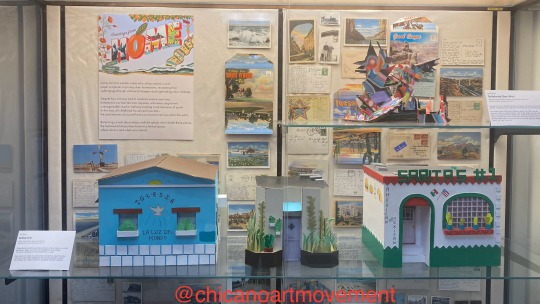
(Detailed view of the works by artist Ana Serrano and Laurie Steelink, respectively.)
The mission statement declared that “‘Greetings from Home’ exhibits artists who utilize ceramics and paper sculptures to portray their hometowns, recreating their upbringings through whimsical imagery and captivating color schemes.”

(First unit of Ana Serrano’s “Building Series,” 2012.)
It was stated by the Escalette Collection that “using cardboard and colorful acrylics, Mexican-American artist Ana Serrano is an architect. Recreating Los Angeles’ low income, Latino neighborhoods, Serrano spotlights ‘the spirit of an unplanned city,’ which captivated as a youth.”
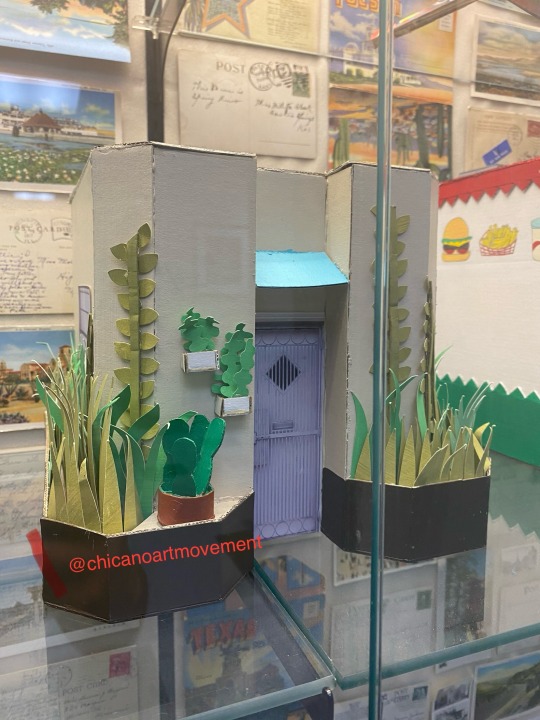
(Second unit of Ana Serrano’s “Building Series,” 2012.)
I learned that Ana Serrano’s “Building Series”works were included. Within Serrano’s series (2012), my favorite was the middle casita with its wrap around garden & cool tones frond door which was a homey touch of this unique little block.
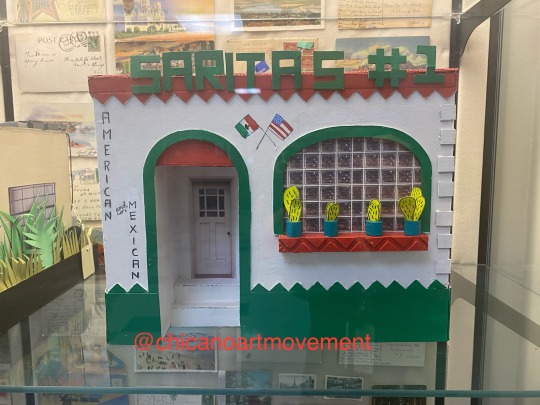
(Third unit named “Saritas #1” by Ana Serranoand part of her “Building Series,” 2012.)
This display was curated by the summer 2023 student interns of the Escalette Permanent Collection at Chapman University.
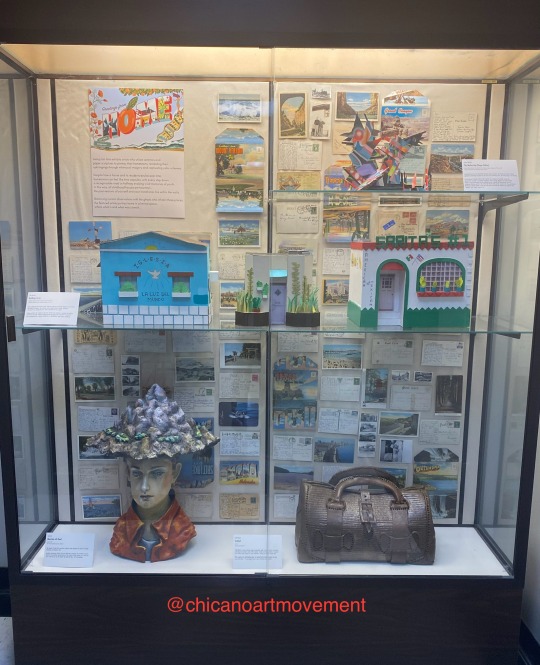
(Full view of all artists featured in the “Greetings from Home” display case located in Moulton Hall at Chapman University.)
Other participating artists were: Laurie Steelink, Jack Earl, and Cliff Hilliard.
8 notes
·
View notes
Text
London, Paris - March 2024
Just back from a fantastic art viewing adventure in the old world which featured stops at the Tate Modern and Goldsmiths Centre for Contemporary Art in London, and the Musée d’Orsay, the Foundation Louis Vuitton and the Bourse de Commerce in Paris. The four-day trip was on the back end of a stay in the 13th century hilltop village of Petritoli, located in Le Marche, where local churches and those in the neighboring towns displayed marvelous medieval and renaissance style treasures. In the big cities, however, the focus was more on contemporary offerings. The whole made for a fascinating journey through an exciting part of art history.
London
An attempt to see the Yoko Ono exhibit at the Tate Modern was stymied by sold out crowds. The serendipity in poor planning however resulted in an opportunistic visit to the museum’s permanent collection, more specifically the magical second floor featuring modern masters and post war stalwarts. With entire rooms dedicated to the likes of Joan Mitchell and Gerhard Richter, among others, the walk-through played out like a greatest hits tour where around every corner an even more marvelous sensory treat was served up. Highlights of the visit included: Georges Braque’s early cubist masterpiece “Clarinet and Bottle of Rum on Mantlepiece”, 1911, oil on canvas (31.9 x 23.6 in.); Giorgio Griffa’s painterly “Tre linee con arabesco n.111”, 1991, acrylic on unstretched and unbleached canvas (114.4 x 76.4 in.); and Agnes Martin’s contemplative grid patterned renderings “On a Clear Day”, 1973, thirty screenprints on paper (each 12 x 12 in.), edition 32 of 50.
On the other side of town on the campus of one of the world’s most renowned art schools, a Matt Connors exhibit, Finding Aid, opened its doors at the Goldsmiths Centre for Contemporary Art. Featuring new and older works by the American abstract artist, the expansive grouping of paintings, sculptures and drawings cleverly paired Connors’ soft geometric abstraction and minimalist marking styles. Showstoppers included: the large-scale bold vertical diptychs “Mural for a Gay Household I” and “Mural for a Gay Household II”, 2018-2020, acrylic on canvas; the vibrant “Red Top (deployed hatch)”, 2015, acrylic on canvas; and the sparse “Echo Implies Room (Orange/unprimed)”, 2012, acrylic and colored pencil on canvas.
Paris
Forty-eight hours later, the Eurostar abetted transition to Paris was speedy and eventless. Even under cloudy skies, the City of Light was totally sublime and uniquely picturesque. The art stops along the way were knockout shows in beautiful venues which in and of themselves were artistic and architectural marvels. At the Musée d’Orsay, the magnificently repurposed train station was the setting for the Paris 1874: Inventing Impressionism exhibit. The show celebrates the 150th anniversary of the inaugural exhibit of the then avant-garde movement and chronicles the transition from staid and traditional realism to hazier and freer interpretations of subject matter capturing a moment in time, an impression, so to speak. The cast of characters that led the way included MVPs in the annals of art history - Monet, Renoir, Degas and Cézanne, among others, all of whom figure prominently in the exhibit. The highlights included: Auguste Renoir’s “La Loge”, 1874, oil on canvas (31.5 x 24.8 in.); Claude Monet’s “Impression, soliel levant”, 1872, oil on canvas (19.63 x 25.63 in.); and Edgar Degas’ “Classe de danse”, circa 1870, oil on wood (7.75 x 10.63 in.).
The next visit on the journey was the futuristic Frank Gehry-designed Foundation Louis Vuitton and the Mark Rothko retrospective. The comprehensive exhibit brought together 115 or so works of the powerhouse American abstract artist and presented a chronology of the evolution of his early figurative renderings to mystical and surreal style paintings and finally, to his entrancing iconic floating forms. The highlights included: the early representational scene “Contemplation”, 1937-1938, oil on canvas; the surrealist masterpiece “Slow Swirl at the Edge of the Sea”,1944, oil on canvas; and dozens upon dozens of mesmerizing large format colour abstractions, including, “Orange and Red on Red”, 1957, oil on canvas (68.8 x 66 in.) and “No. 14”, 1960, oil on canvas (114 x 105 in.).
The last planned stop in Paris was the Pinault Collection at the impressively remodelled Bourse de Commerce. Spiralling up the majestic rotunda, works by contemporary art rockstars were prominently displayed. Among these were: Peter Doig’s haunting “Pelican (Stag)”, 2003-2004, oil on canvas; Maurizio Cattelan’s poignant “Him”, 2001, wax, human hair, suit, polyester resin and pigment; and a monumental installation by Sturtevant replicating the mythical room staged by Marcel Duchamp at the 1938 International Surrealist Exhibition in Paris.
Closing off the trip and reaching back in the art history timeline, a truly memorable work was discovered by happenstance during an unplanned visit to Eglise Saint-Séverin. Dating back to the 13th century, the gothic style place of worship housed numerous elaborate chapels which were all built around altars and adored by art of the time. A particular work stood out as it was presented alone hung high on a huge wall under a circular stained-glass window surrounded by nothing else but the serenity of the immediate environment. It totally radiated under the spotlight that illuminated a depicted religious figure sitting at a table who perhaps was Saint Séverin, a devout 6th century hermit and the church’s namesake.
Meanwhile, in the new world, there was a lot more commotion as Hogtown’s Jurassic Park was hit with an asteroid of epic proportions that essentially wiped out all remnants of a recent championship team. The Dinos were dissected and dismantled. Gone are Crazy Eyes and OG-Won Kenobi, and team leader Scottie B and the much-maligned Austrian Big succumbed to season ending injuries. All the while, the newly minted Raptors including RJ the Prodigal Son Barrett and Immanuel La Squig Quickley struggled to stay healthy and make their mark. The result has been a team that is nowhere near relevant in the standings nor the hearts of fans. With the prospect of a lengthy and bumpy rebuilding process ahead, Dino fans can perhaps take some solace in rooting for the success of Raptor expats applying their trade elsewhere or maybe even Canadian hoopsters playing for true championship contenders. It’s all a lot rosier than the current state of affairs in Jurassic Park.
For more information on any of the venues, artists or works mentioned, or the sad sack Dinos, “Just Google It”.
There you have it sportsfans,
MC Giggers
(Https://mcgiggers.tumblr.com)
Reporter’s Certification
I, MC Giggers, hereby certify that the views expressed in this report accurately reflect my personal views and that no part of my compensation was or will be, directly or indirectly, related to the specific views expressed herein.
I also certify that I may or may not own, directly or indirectly, works of artists mentioned in this report and that I may or may not have a strong bias for such artists and, more generally, for “Pictures of Nothing”.
#mcgiggers#art beat#raptors#tate modern#goldsmiths#foundation louis vuitton#bourse de commerce#pinault collection#georges braque#joan Mitchell#Gerhard richter#giorgio griffa#agnes martin#matt connors#finding aid#Mural for a gay household#Red top#Echo Implies room#paris 1874#musee d'orsay#la loge#impression#soliel levant#monet#degas#classe de danse#rothko#contemplation#slow swirl at the edge of the sea#orange and red on red
2 notes
·
View notes
Text
Dusty Blue Candy Table Lamp
A petite dusty blue candy-style table lamp, in glass and acrylic, originating from USA in the 1970s. The body of this piece is in an Art Deco-inspired ridged glass shell pattern which is painted inside, making it look like candy. The lamp sits atop a clear acrylic base. it would look great either in the kids room or any other interior.
Please note this lamp does not come with a shade and the shade on images is only for display purposes. We can help you pick out a shade if so required. The lamp is currently wired to an American plug, but we can change this depending on the buyer's location.
CREATOR: Unknown
PLACE OF ORIGIN: USA
DATE OF MANUFACTURE: c. 1970's
PERIOD: 1970 - 1979
MATERIALS & TECHNIQUES: Glass, acrylic, brass
CONDITION: Very good original condition.
WEAR: Wear consistent with age and use.
HEIGHT: 30cm | 11.8in
WIDTH: 18cm | 7in
DEPTH: 15cm | 5.9in
Request More Information
#jeanclaudemahey#jean claude mahey#mahey#table#table lamps#brass#chrome#vintage#retro#midcentury modern#love#gabliella crespi#willy daro#interiors#furniture#lights#lighting#decoration#lacquer#romeo#restoration#renovation#romeo rega#rosewood#regency#ralph pucci#regency hollywood#travertine#Arne Jacobsen#ground one six
3 notes
·
View notes
Photo





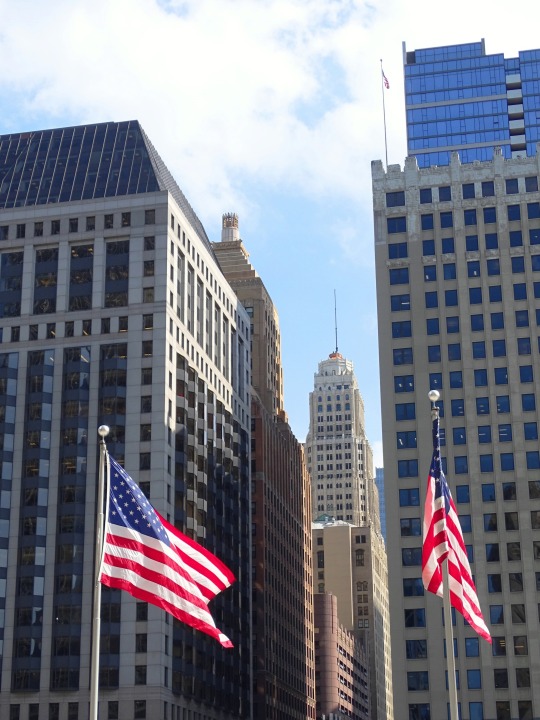

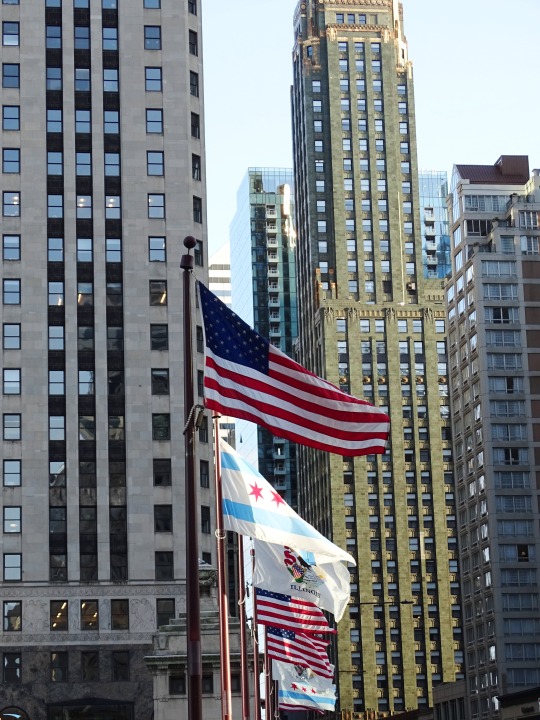


National Flag Day
Whether it's waving in the wind or printed on your favorite t-shirt, this symbol represents a nation founded on freedom and hope.
It’s time to rally round… Whether it’s a huge Stars and Stripes flapping on the porch, or just a lapel pin, find a way to mark a unique day in a unique nation. Pay some respect to this notable national flag of the United States of America on National Flag Day!
History of National Flag Day
This important day can trace its roots back more than 100 years when United States President Woodrow Wilson, on May 30, 1916, issued a presidential proclamation declaring June 14 to be National Flag Day. Honoring the flag that now bears fifty stars and thirteen stripes, this day commemorates the day in 1777 when the approval for the first national flag was made. Though National Flag Day is not an official federal or government holiday, it is still an important time to celebrate.
Of course, the flag has gone through a few different iterations over the years. Originally containing thirteen stars and thirteen stripes, as the country grew, the flag changed. The most recent change was on July 4, 1960, when two more stars were added to celebrate the addition of two new states to the union: Alaska and Hawaii.
While the Fourth of July has become an all-around celebration of the birthday of America, National Flag Day has kept more of a local character, with traditions rooted in the township or the county, the city or the state capital. And much more than for family festivals, it feels right to be celebrating it with your team, club or class.
Every year, people are invited to discover their inner Betsy Ross and make their own versions of Old Glory, in everything from stained glass to potato prints to rows of flowers. The men who adopted the first flag, way back in 1777, could hardly have imagined it. Three cheers for all things red, white and blue with stars and stripes on National Flag Day!
How to Celebrate National Flag Day
Show some support for the meaning of the US Flag by celebrating National Flag Day with a variety of activities, including some of these:
Display an American Flag
One of the most important things to do on National Flag Day is to show a bit of American pride by flying a flag. Hang it on a pole on the outside of the house, raise one up a flag pole or place one on the desk at the office.
This is a great time to show a bit of patriotism and loyalty to the fifty white stars and thirteen red and white stripes. But remember, to adhere to the US Flag Code, if a flag is flown outside, it should be raised in the morning and taken down at sunset each day.
Visit the Betsy Ross House
The story goes that a woman named Elizabeth Griscom Ross, who was a seamstress for George Washington, was the person who made the first flag, commissioned by the president and two of his colleagues. The legend has been passed down through the Ross family for more than two centuries. Tourists can head over to the Betsy Ross House, located in the Old City neighborhood of Philadelphia, to take a tour of the place and learn more about the history of Old Glory.
Try Making Some American Flags
One interesting activity to enjoy in celebration of National Flag Day might be to get creative with some stars and stripes of your own. A variety of mediums could be employed, from watercolor or acrylic paints to crochet or knitting with yarn, it’s fun to see what ways a flag can take shape.
Parents and teachers can help school aged children or preschoolers using popsicle sticks, perler beads, paper plates or other crafting materials. Or just keep it simple with some white paper and some crayons or colored pencils. National Flag Day has never been so much fun!
Source
#Sonoma#Alamosa#Bunny Foo Foo by Lawrence Argent#Chicago#St. Helena#Paoli Massacre Monument#Chaffee County#DeWitt#Iowa#USA#Illinois#Turnbull Wine Cellars#Hall Winery#Colorado#California#National Flag Day#14 June#travel#vacation#summer 2022#2019#cityscape#landmark#landscape#architecture#tourist attraction#Rocky Mountains#NationalFlagDay#original photography
2 notes
·
View notes
Photo

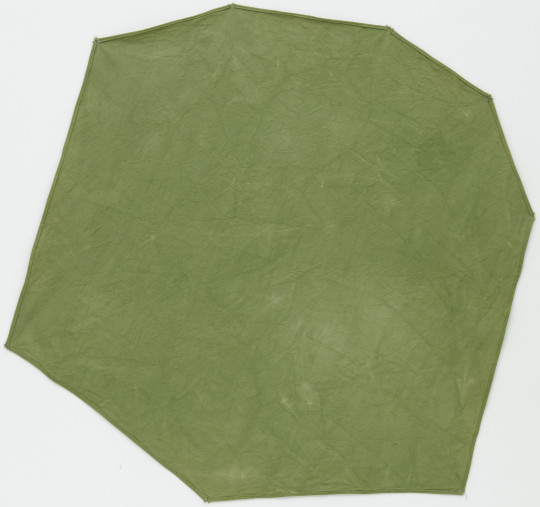
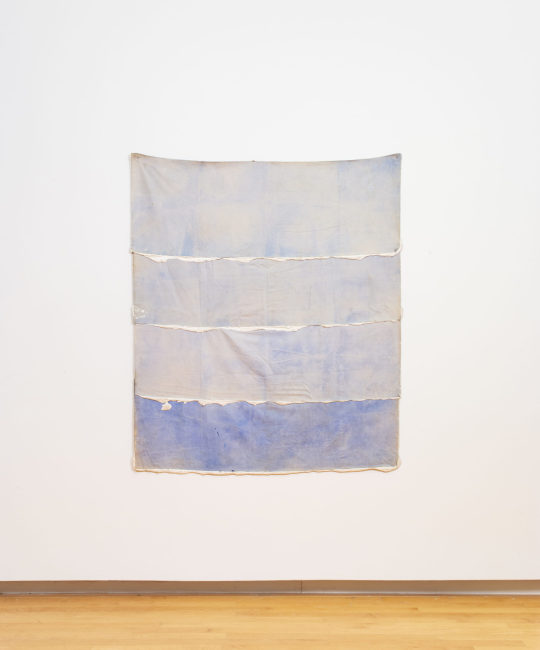


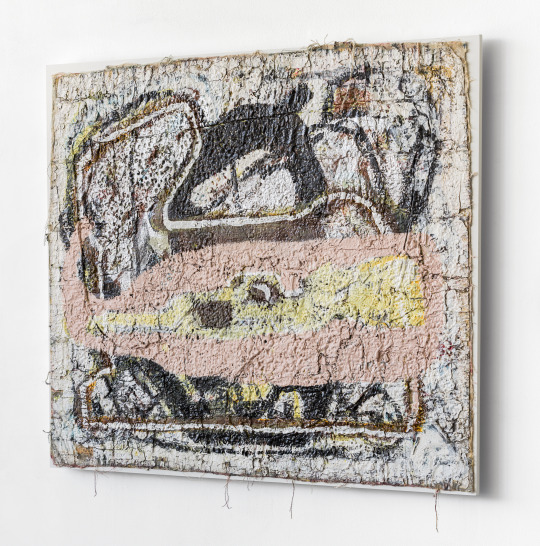
This series of images show unstretched canvases and textile art. Cali has been painting on unstretched canvas, and has expressed an interest in presenting these works in that form. Unstretched paintings are very material-forward in that we are forced to see them, first and foremost, as objects hanging on the wall (as opposed to windows opening onto a scene). Here are a few examples, beginning with Minimalist painter Robert Ryman’s tiny, barebones work of brush marks on rough, unsized canvas, displayed inside of a protective frame. Richard Tuttle’s Cloth Octagonal is something else entirely, a shaped soft object dyed green and attached to the wall with nails or pins. Mary Heilmann may have been inspired by Tuttle’s work, but her work feels more like a painting in its materials and rectangular shape. Heilmann’s later canvases are stretched in the conventional manner.
Richard Hambleton was a graffiti artist, in the 1980s, whose “Shadowman” figures appeared on walls of the Lower East Side of Manhattan. His work made the jump to galleries along with that of the better known Keith Haring and Jean-Michel Basquiat. Carole Harris is a textile artist; it has long been the norm to display tapestries and weavings by simply hanging them. The last artist, Michael Luchs, was deeply concerned with surfaces and textures; his paintings have a fragility that requires some sort of support, but using a stretcher or conventional frame would seem to be out of the question. Mounting them on painted plywood, as seen here, allows the viewer direct, unimpeded access to his layered, painted, hole-punched surface, along with rough details such as the dangling yarn of his unravelling canvas.
Robert Ryman (American 1930-2019). Untitled 1959. Oil on unstretched cotton canvas, 7 1/8 x 7 3/8 inches. Source.
Richard Tuttle (American b. 1941). Cloth Octagonal, 2 1967.Dyed and sewn canvas, 57 1/8 x 53 3/4 inches. Museum of Modern Art, New York.
Mary Heilmann (American b. 1940). Malibu 1970. Acrylic gel on unstretched canvas, 64 1/4 x 55 inches. Source.
Richard Hambleton (Canadian 1952-2017). Untitled 1983. Acrylic on canvas, 74 x 48 inches. Source.
Carole Harris (American b. 1943). Flowers for Breonna 2020. Mulberry paper, thread, fabric; 19 x 21 1/2 inches. Source.
Michael Luchs (American 1938-2021). Untitled (Rabbit) 2014. Mixed media on canvas, mounted on wood board; 42 1/2 x 53 1/2 inches. Source.
3 notes
·
View notes
Text
Braille puzzles to tactile paintings: this Chennai art exhibition has an inclusive display - The Hindu

Tactile tigers, sculptures that sign, and a Braille puzzle on a canvas.
At Apparao Gallery today, accessibility leads the conversation, for artworks - some interactive - by 10 artists with disabilities that occupy the otherwise conventional gallery space that Chennai’s collectors frequent. An abstract, panelled work and realistic portraits of the national animal of India, complemented by an experimental series of acrylic flora that spills over canvas frames, kickstart the display that do not follow a narrative per se. Mediums are aplenty - from acrylics and clay to paper and cloth make an appearance through canvases that hope to catch the collector’s eye. Dubbed a sensory art exhibit, the display hopes to cater to senses other than just sight and in essence advocates inclusivity even from a viewer’s perspective.
The artists who mostly hail from Chennai and Tamil Nadu are part of Kai Rassi, a not-for-profit organisation that leads vocational art programmes and creates inclusive spaces for artists with disabilities. And this marks their fourth formal exhibition. As the display opens, each of them stands guard next to their respective artworks, eager to fill the audience in on their idea behind each concept, while busy interacting with fellow artists who they share space with. For founders Divya Rao, Kadambari Narendran and Indira Reddy, the display is meant to be more than just ‘disability-driven’. Divya says, “Then, the buyer who comes in is not looking for anything more than just donating money. We wanted to change that. We wanted to make them aware that they are also getting something beautiful in return.” The idea is to make galleries want to collaborate with each of the artists in an individual capacity.
Midway, a series of 11 clay sculptures fashioned by students from the Mary Clubwala Jadhav School for the hearing impaired, makes for an interesting break in the narrative. They make one pause, and pay attention. Each sculpture is a hand mould with the imprint of each students’ hand. They depict letters from the American and Indian sign language, paired with pictures of students signing them, and read “We are Hear”: a witty take on the very disability that ostracises them. Visual artist Shreya Chajjed who led this particular project says, “They were really excited about the medium, and went about it very smartly. We rehearsed with them before making the final models.”
The showstopper perhaps is the work by UK-based, partially-blind artist Clarke Reynold, accompanied by leaflets with patterns that denote each alphabet. The viewer can use this leaflet as reference to interpret the words on the canvas. The takeaway is the message. The collaborative work is put together through a virtual workshop with students from Lady Andal IB, Yein Udaan and girls from Prem Vihar.
One of the works on display | Photo Credit: Special Arrangement
Aishwarya is elated. The hearing and speech-impaired artist, who specialises in many mediums of painting, has worked with fine paper-cutting this time. The delicate, concentric circles which are sometimes embellished with gilded paper, takes her nothing less than a week of work. As for Lokesh whose penchant for animal forms has been established through his acrylic works, made signs to the interpreter who translates, “The national animal of India has always fascinated me. Sometimes, I see photographs of these big cats and try to trace them onto canvas.” He points to a black-and-white series of canvases with bulls in motion and says, “But when I think of Tamil Nadu, bulls come to mind.” He is hearing-impaired.
For Anthony, who has been a carpentry and art teacher for the past 34 years with a special school in the city, art equals functionality. The unusual canvas frames on which acrylic paintings of flora spill out, came out of the need to be unique. “I wanted to do something that is a little different, which will look good in a home,” he says. He had polio as a three-month old baby. An independent artist, he strives to remove the stigma around people with physical and intellectual disabilities.
Betsy’s acrylic works speak of minute skill. Serpentine shadows fall on a path laden with trees. A tactile version of the work, by Access for All, accompanies the frame. Pavithra’s abstract series is a study on gradation of colours, blue being her muse. Siva’s line drawings on the other hand have already gained him a good following and recognition, says Divya.
The display will be on till April 2 at Apparao Gallery, Nungambakkam
This content was originally published here.
3 notes
·
View notes
Photo

The 3rd Annual Morgan County Veterans Creative Arts was a success! Several Bloomington artists joined Martinsville creative spirits at the Art Sanctuary to display their hard-work! It was a site to see as Veterans and artists bonded together over their service to country and their love to create! We also had 2 youth display extraordinary pieces exhibiting talent, but also providing honor to the Veterans they are related to! American Legion Auxiliary Unit 18 Bloomington was blessed to have the opportunity to be a part of a tradition that American Legion Auxiliary Unit 230 Martinsville created a few years back! it was neat to see several different. American Legion entities collaborating together to ensure our veterans were able to participate in an event that provided an outlet for their talents and allow them an opportunity to express themselves. Placements are as follows: Youth Open Category Winners Emma Smith Colored Pencil with the Essay-“Gold Star Soldier” Adriana Terry Stained Glass- Gray Loves” Collage 1st Place Randy Allen -“Arrows in a Box” 2nd Place Robin Hall-“Just a Little Jazz” Photography 1st Place Deedra Thombleson-“Buzzing Around” 2nd Place Larry Hinkle-“Miss Madison” Pencil 1st Brad Mobley-“Old Friends” 2nd Otis Frank Bock- “Cherries” Woodwork 1st Jerry Wells-“Mushroom Walking Stick” Leatherwork 1st John Liford - Sadle Rifle Scabord Oil 1st Sue Purpura-“Tiger Resting” 2nd Ron Garrett- “Vintage Indy Car Acrylic 1st Glen Folco-“Courthouse” 2nd Frank Disilvestro-“Sea Valor” Watercolor 1st Ronald Ferry-“The Mighty Hawk” 2nd Richard Wilson-“Yellow Truck” Gallery Vote- Best in Show - John Liford with leatherwork pieces It was an incredible event!!! Thank you Dani Fluhr and the committee for your hard work in planning this!
0 notes
Text
✨ Discover the Elegance of Seasons of Change Acrylic Art: Dynamic Nature Showcase ✨
Dive into the heart of luxury with our latest masterpiece, Seasons of Change Acrylic Art: Dynamic Nature Showcase. A true emblem of sophistication, this piece is a must-have for anyone who appreciates the finer things in life from the collection . 🎨🖼
The Artistic Seasons of Change Acrylic AI Showcase Wall Art explores the profound beauty and transformative energy of the changing seasons. Through vibrant colors and dynamic compositions, this artwork captures the essence of nature's cycles, presenting a visually stunning narrative of growth and renewal.
Material: Utilizing high-quality clear acrylic with a white vinyl backing, the artwork presents the changing seasons with striking vibrancy and detail, akin to the clarity of a high-definition window into nature.
Depth: At 0.75 inches (1.9cm), the art piece achieves a floating effect, enriching any space with its visual depth and engaging perspective.
Glass-Like Finish: The sophisticated second-surface printing on a ¼” thick acrylic panel brings the seasonal changes to life with a glossy, reflective quality that enhances the artwork's dynamic appeal.
Ready to Hang: Prepared for immediate display, this piece is designed to float 1.5” off the wall, with rounded corners for a sleek, contemporary look.
Made in the USA: This showcase is a celebration of nature’s perpetual beauty and the innovative spirit of American artistry, assembled with the utmost care and quality.
The Artistic Seasons of Change Acrylic AI Showcase Wall Art invites viewers on a visual journey through the beauty of nature’s seasons, perfect for anyone looking to infuse their living space with the vibrant and ever-changing tapestry of the natural world.
Whether you're looking to elevate your living space or searching for that perfect statement piece, Seasons of Change Acrylic Art: Dynamic Nature Showcase promises to transform any room into a gallery of modern elegance. With every brushstroke and color, experience a blend of tradition and contemporary artistry that only Lux AI Art can deliver.
Don't just take our word for it. See it for yourself here: https://luxuryaishop.com/product/artistic-seasons-of-change-acrylic-ai-showcase-wall-art/?feed_id=2195&_unique_id=66c21f8762762 🔗
Join us in celebrating the beauty of art. Share your thoughts and let us know how Seasons of Change Acrylic Art: Dynamic Nature Showcase inspires you. 💬
#LuxAIArt #EleganceInArt #ModernMasterpieces #ArtLoversUnite #LuxuryDesign #ArtCollectors
1 note
·
View note
Text
Gallery visit: Museum of American Art (3.7.24)
Nam June Paik's television works
Rows 1 and 2: Electronic Superhighway: Continental U.S., Alaska,Hawaii (1995, installation - 51-channel video installation (including closed-circuit television feed; colour, sound), custom electronics, neon lighting, steel, and wood)
Row 3: Zen for TV (1963/1976, manipulated television set)
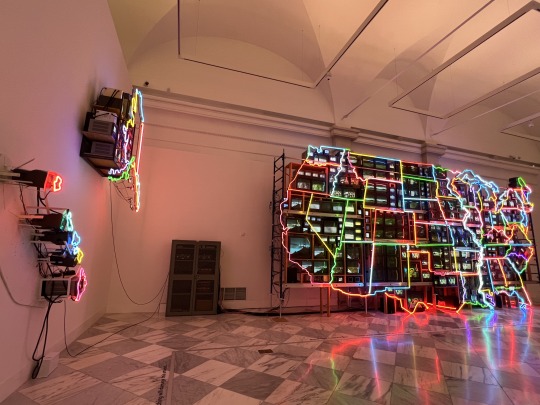


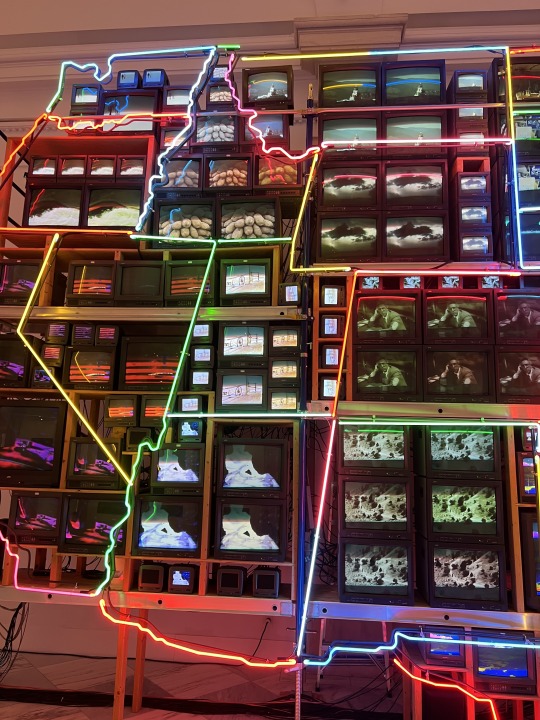
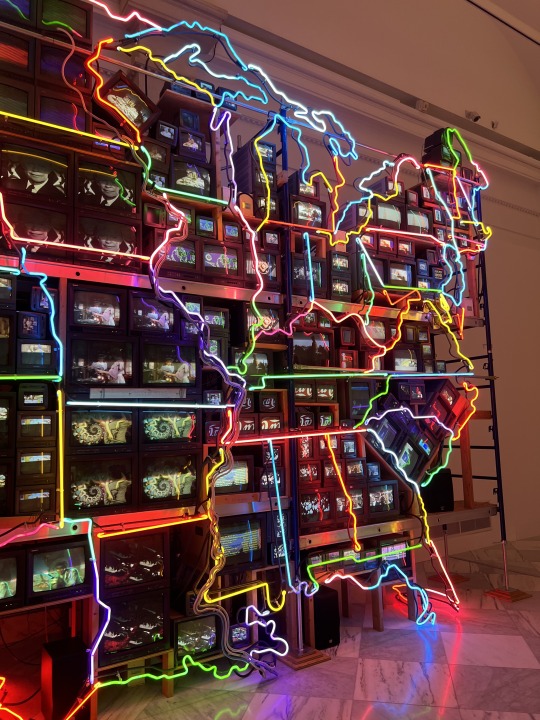
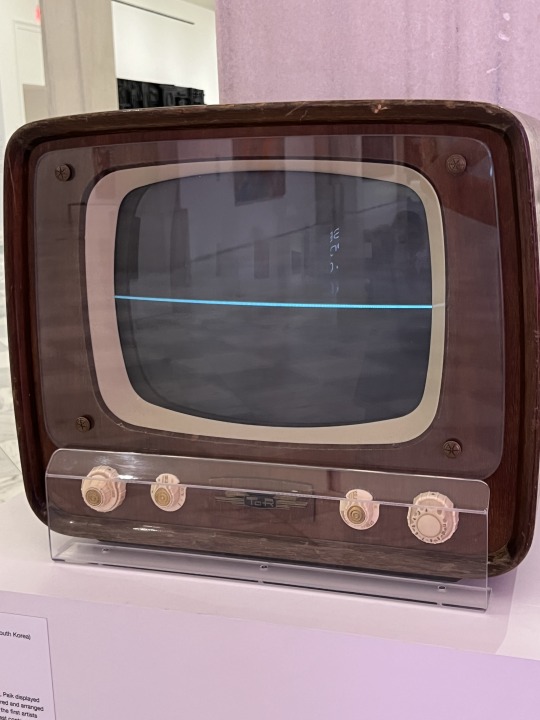
Description for Electronic Superhighway: Continental U.S., Alaska,
Hawaii (1995): "Paik predicted, in 1965, that "someday artists will work with capacitors, resistors, and semiconductors as they work today with brushes, violins and junk." Over the decades, his own work stayed in constant conversation with how new technologies reshape the world. Electronic Superhighway playfully engages three such forces: the US interstate highway system, cable television,
and the emergent internet of the 1990s.
In this TV map, neon-outlined states play a mix of borrowed and original footage. Each distinct channel reveals Paik's associations with or understanding of that state. Some video collages draw from personal connections, like Paik's recordings of longtime collaborator and cellist Charlotte Moorman filling the screens in her home state of Arkansas (along with images of then president Bill Clinton, also from Arkansas). Others incorporate existing media representations, with the movie musical Oklahoma! filling Oklahoma, and edits from a documentary on the 1950s Montgomery bus boycotts echoing from Alabama.
A closed-circuit camera marks Washington, DC, where gallery visitors can see themselves in real time. This suggests the map is also a portrait, reflecting how media and mediation shape views of ourselves and each other at national, regional, and individual levels."
Description for Zen for TV (1963/1976): "In a 1963 exhibition in Germany, Paik displayed a room full of electronically altered and arranged televisions, making him one of the first artists to use actual TVs and broadcast content to make art. One set arrived broken, compressing all received signals into a thin line of light. Paik embraced its broken state and titled it Zen for TV, playfully and profoundly linking its accidental minimalism to the meditative focus of Zen Buddhism, a religious reference he often used to signify an Asian perspective in Euro-American contexts. Zen for TV became one of Paik's signature works, and over the years he created select versions like this one."
Firelei Báez's Untitled (Premiere Carte Pour 'Introduction à L'Histoire du Monde) (2022, oil and acrylic paint on archival printed canvas)
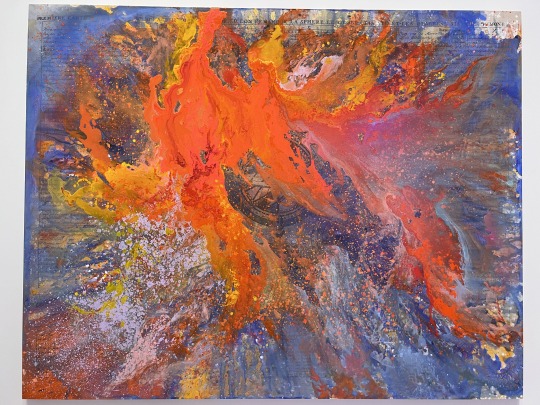
Description: "What do you see in Firelei Báez's plumes of orange, red, and blue? Her painting might evoke the eye of a hurricane, an exploding supernova, or consuming flames.
Beneath the swirling streams of paint lies an image of the Atlas Historique, a map created in 1718 to document the recently conquered European colonies. Charting the farthest reaches of human knowledge at that time, the Atlas joined the earth, the solar system, and the constellations into one view.
Originally from the Dominican Republic, Báez thinks about the ways her own life has been shaped by the legacies of colonialism. She sees her art as a conversation with this earlier period, opening up space for questions and alternative histories. Here, she might be imagining the world represented by the Atlas ending in dramatic fires and floods. Or she could be continuing its traditions: her own imagery was inspired by the fantastical pictures of outer space transmitted by the James Webb Space Telescope in 2021 - today's equivalent of the eighteenth-century star map."
Thornton Dial Sr.'s The Beginning of Life in the Yellow Jungle (2003, plastic bottles, doll, clothing, bedding, wire, found metal, rubber glove, turtle shell, artificial flowers, Splash Zone compound, enamel, and spray paint on canvas mounted on wood)
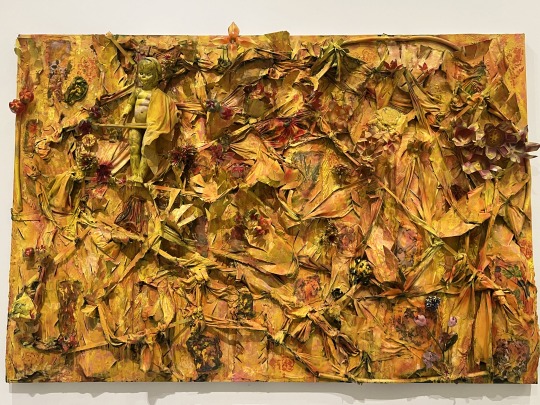

Description: ""When I start making something, I gather up the
pieces I want to work with." Thornton Dial once explained. "Everything I pick up be something that done did somebody some good in their lifetime.. When you make things beautiful out of another person's ideas, it make the world more beautiful."
Dial mastered the art of speaking through objects-he gathered, combined, and painted them to create artworks that ask us to look closely and think carefully. Here, he invokes a jungle landscape, a place where survival can be hard. In Dial's 'jungle scape', wild and urban realms are indistinguishable: plastic cups and bottles are plants, rubber gloves and rags are vines. The entire scene is conjured from something found, repurposed, and reimagined.
Across nine decades in Alabama, Dial experienced racism and oppression firsthand, but he discovered that he could speak freely through artmaking. Dial's critiques of race relations were often somber, dark in color and mood. Yet here, warm hues shower the day in optimism; polarised divisions of black and white give way to a sunny palette of possibility."
Louise Nevelson's Sky Cathedral (1982, painted wood)
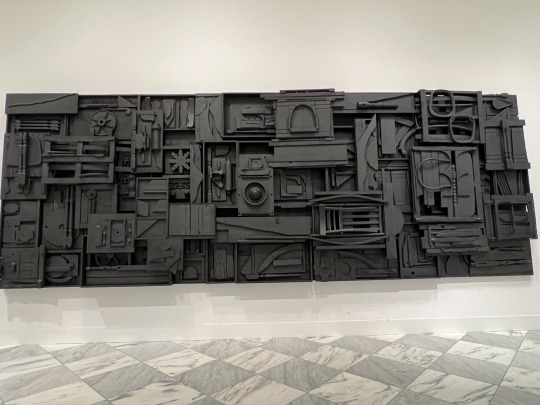
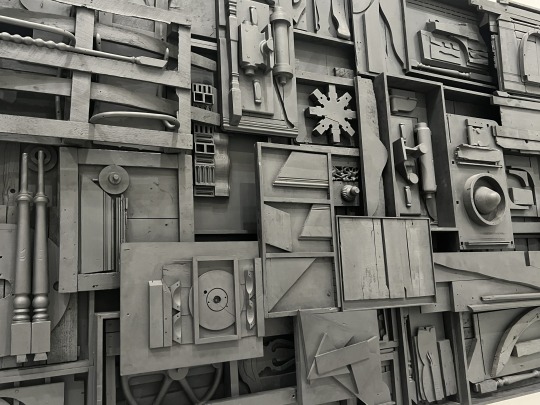
Description: "Can you identify any of the everyday objects in
the black field of Sky Cathedral?
Louise Nevelson was an avid collector of objects, and she assembled various found wooden scraps - table legs, bannisters, rolling pins, milk crates, mouldings, and other architectural fragments-to create her sculptures.
Although it's possible to see the shapes and outlines of these elements, they are absorbed into the large, uniformly painted black wall.
Nevelson aimed to create a spiritual experience out of everyday objects, transforming them from the material to the immaterial. Sky Cathedral evokes what Nevelson called "the heavenly spheres, the places between the land and the sea" that lie beyond our experience of ordinary things."
Alfred Jensen's Honor Pythagoras, Per I-Per VI (1964, oil paint on canvas)
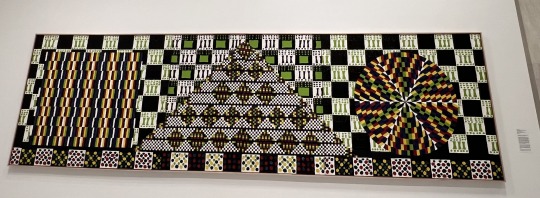



Description: "Alfred Jensen strove to reveal the connections between art, science, and spirituality.
For him, the thousands of strokes of colour that he applied across these six conjoined canvases expressed the unity of all things. The coloured triangles represent prisms that break white light into brilliant hues, and the geometries and numbers underlie the basic order of the universe.
Jensen was inspired by mathematics, but also by visual forms from around the world, including calendars and counting systems from Arabic, Mayan, and Chinese cultures.
The painting - one of the artist's largest - contains complex symbols and ideas, yet it operates very simply on another level: undiluted colour, shape, and rhythm combine to create a harmony that appeals to the eye and the body as much as to the mind."
Kenneth Victor Young's Untitled (1973, acrylic paint on canvas)
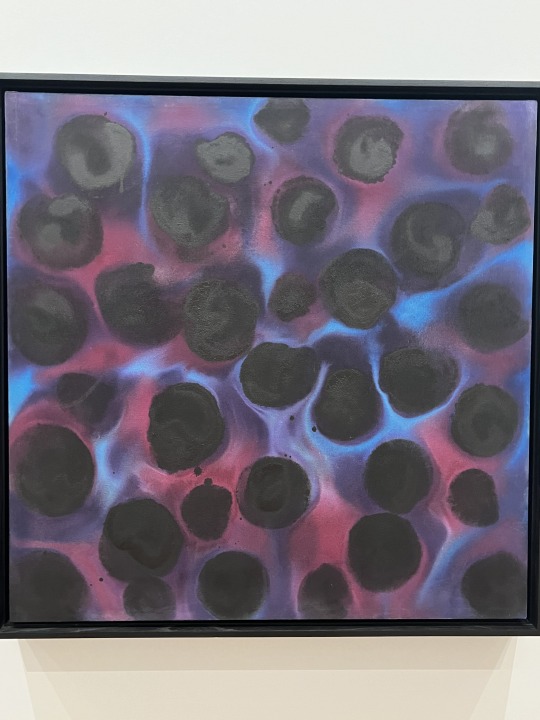
Description: ""I've always been interested in … outer space,
inner space, and the development of what occurs - force, magnetism, and that kind of thing." - Kenneth Victor Young
In Untitled, Kenneth Victor Young cultivates an uncertain sense of space and scale. Black orbs float in a dark field, potentially representing either a microscopic or celestial view. The colorful halos
around the orbs were created by applying paint "wet into wet" and allowing it to freely blend and move.
Like Sam Gilliam, whose unstretched painting Swing hangs nearby, Young grew up in Kentucky and studied painting at the University of Louisville before moving to Washington, DC, in the 1960s.
Only after settling in DC, did either artist begin working in a fully abstract mode."
Simon Gouverneur's Mara (1989, egg tempera, acrylic paint and coloured pencil on canvas)
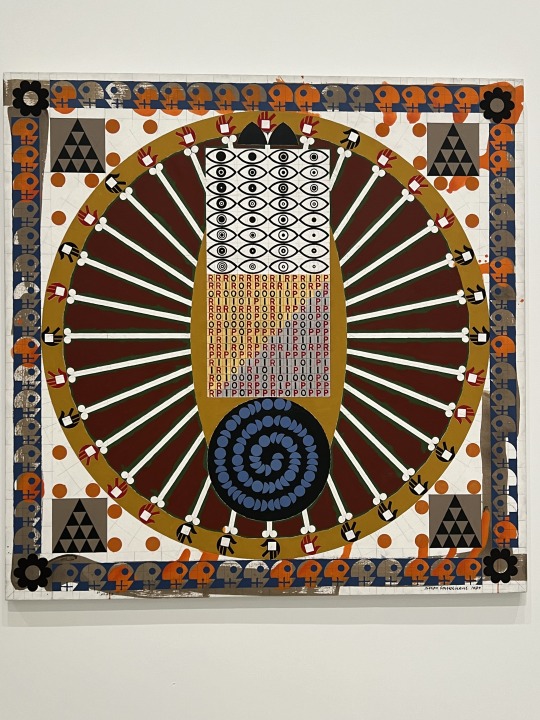
Description: "With its rings of colorful shapes and patterns,
abstracted eyes, hands, pyramids, and letters, Mara appears to be at once puzzle and code.
Simon Gouverneur constructed his compositions from a visual vocabulary of images and symbols derived from various religions, including Buddhism, Hinduism, Jewish mysticism, and ancient American traditions. Influenced in part by the painter Alfred Jensen-whose work is on view nearby-he sought to reveal a universal language that joined spiritual practices across cultures.
Gouverneur worked very slowly: he mixed his own pigments, rather than relying on commercially available paints, and applied his paint with many tiny, meditative strokes. His methodical process connected him to generations of artists but existed in tension with the expansive and mystical experiences he aimed to create."
Gretchen Bender's TV Text & Image (DREAM NATION) (1989, live television broadcast on a monitor with vinyl lettering)

Description: "How does today's news relate -or not-to your idea of a "dream nation"?
Unlike most screens in an art gallery, this monitor is not showing prerecorded, artist-made imagery. Instead, the artist intervenes in regular broadcast television by printing DREAM NATION on the surface of the screen. Gretchen Bender's work invites you to contrast your current take on these words with what is on TV at this very moment. When displayed in the nation's capital of Washington, DC, it can also feel site-specific, invoking this country's dreams and dreamers.
Bender was part of a generation of artists, including Barbara Kruger (whose work is on view nearby), who responded to the rising power of mass media. Using what she described as "guerrilla tactics . . . to make some kind of break or glitch in the media," Bender took on television to make the "underlying patterns of social control" visible."
Kapulani Landgraf's Puka mai (2002, handwoven silver gelatin collage)
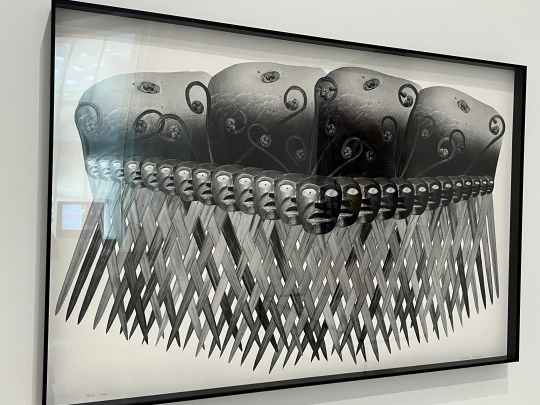
Description: "Made from hand-cut and dry-mounted photographs, Puka mai calls for Kanaka 'Öiwi (Native Hawaiians) to hold on to their connection to their birthplace and thus their ancestors. The images that make up the collage reference important metaphors to the indigenous people of Hawaii.
At bottom, the long, pointed bills of marlin fish - traditionally used by Hawaiians as daggers - are woven together to suggest the aboveground roots of the hala tree, symbolically securing Hawaiians to their homeland. Above the bills runs a line of 'aumākua (family gods) sculptures topped by images of hö'i'o (young fern shoots).
The unfurling shoots represent future generations of Hawaiians."
Isaac Julien's Lessons of the Hour (2019, short film installation - 28 mins 44 secs)

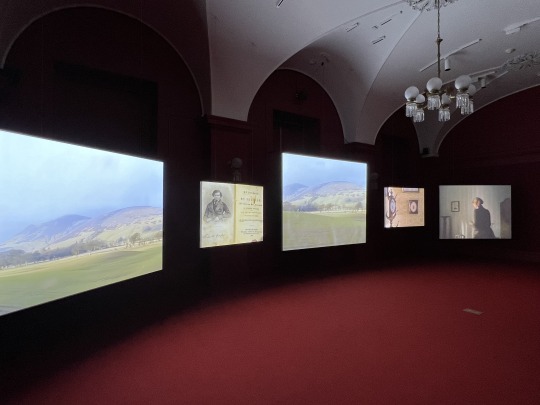
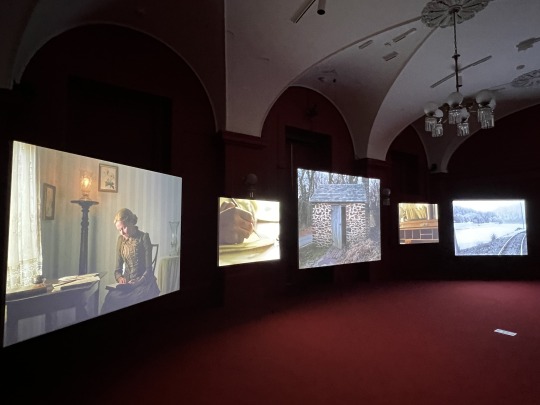





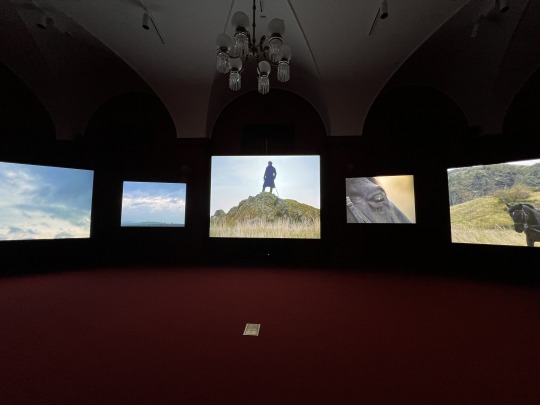

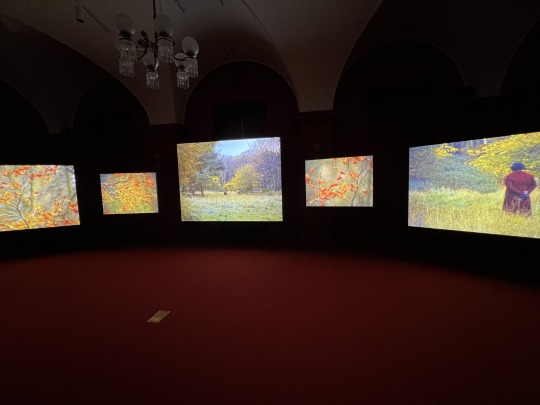
Description: "Sir Isaac Julien's Lessons of the Hour immerses us in the towering legacy of abolitionist, writer, and philosopher Frederick Douglass (1818-1895). Julien, an innovator of moving-image installations, interweaves period reenactments across five screens to share a vivid picture of Douglass's world. Douglass gave thousands of antislavery lectures, several of which focused on photography's power in "reaching and swaying the heart by the eye."
Julien draws dialogue for Lessons of the Hour from three of Douglass's speeches. Additionally, the artist meticulously restages the studio of African American photographer J. P. Ball (1825-1904). There, Douglass, the most photographed American of the nineteenth century, sits for his portrait. Julien also filmed Douglass's historic home in Washington, D.C., with actors playing Douglass's first wife, activist Anna Murray Douglass (c. 1813-1882), and his second, Helen Pitts Douglass (1838-1903). Julien includes them and the abolitionist's wider circle to emphasise how collective action produces radical change.
Footage of contemporary Baltimore, the city where Douglass escaped enslavement in 1838, interrupts these reenactments. We witness fireworks erupting over Baltimore harbor and FBI aerial surveillance of protests over Freddie Gray Jr.'s 2015 death in police custody. During this sequence, Douglass, played by Royal Shakespearean actor Ray Fearon, recites his speech "What to the Slave is the Fourth of July?" Entangling past and present, Lessons of the Hour poses Douglass's prophetic question to us.
Lessons of the Hour represents the first joint acquisition between the National Portrait Gallery and the Smithsonian American Art Museum. As Julien brings Douglass's work to bear on "this very hour," we hope this installation, displayed at the center of our nineteenth-century building, will inform your experience of both museums' historic collections. Through deep research, creative speculation, and a marriage of poetic image and sound, Julien foregrounds Douglass's enduring lessons on abolition, justice, and freedom."
1 note
·
View note
Text
Judy Chicago, the Metaphor of Sex and Art
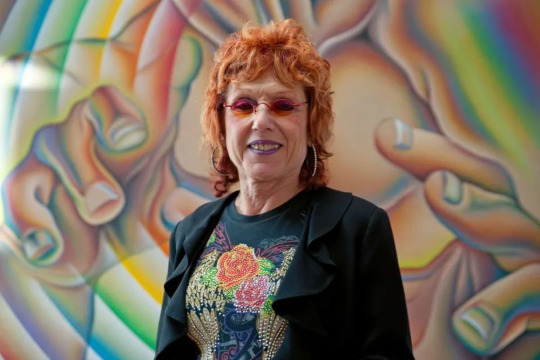
Judy Chicago was born on July 20, 1939, and she became a well-known artist, art educator, and creator of the first feminist art programme in the United States at California State University, Fresno. She is an American feminist artist whose intricate and narrowly focused installations contributed to the women’s liberation movement’s visual presence in the 1970s and beyond. The artist, Judith Sylvia Cohen, was born in Chicago, Illinois, and went to the University of California, Los Angeles, and the Art Institute of Chicago. She began drawing at age five, inspired by her mother, May Cohen, who encouraged her love of the arts.
Judy characterises her previous pieces as minimalist. She worked with pyrotechnics and explosives as performance art, manipulating coloured smoke flashes to create “atmospheres” outside. She debuted as a solo artist at the Rolf Nelson Gallery in Los Angeles. Then, she was one of only four female painters to appear in the Jewish Museum’s inaugural major minimalist exhibition. She made a series of abstract paintings called “Pasadena Lifesavers”, using acrylic paint on Plexiglas to explore her sexuality.

To give the impression that the shapes “turn, dissolve, open, close, vibrate, wiggle,” these works combined colours to depict her realisation that “she was multi-orgasmic.” Her research on women’s sexuality and representation underwent a dramatic sea change after the release of the series.
Chicago’s “The Birth Project” (1980–1985) and “The Holocaust Project” (1985–1993) continue to explore themes related to women’s lives. “The Dinner Party,” her most well-known piece, is permanently displayed in the Brooklyn Museum. The installation consists of a large ceremonial feast on a triangle table, honouring women’s history with sitting arrangements meant for 39 legendary and well-known ladies from mythology. Beneath the triangular table, on the white tile floor, are the gold-inscribed names of nine hundred and nine women.
Judy Chicago and the Feminism
‘Chicago’s fascination with women’s history is one of the defining aspects of her feminism and one of the features that mark her as part of her generational cohort. For Chicago and others coming into feminist consciousness in the late 1960s, the pressing need for a usable women-centred past enlisted history as an element of their political practice. Feminists in the early 1970s also focused on women’s daily resistance practices and renewal strategies. For Chicago, this focus on “ordinary” women would eventually translate into her attention to needlepoint, china painting, and other art forms dismissed by the art world as “craft” in The Dinner Party. But in 1970, women’s history, which she was most interested in writing, was what she called “female art history.” This would involve an intense focus on the female body’, writes Jane Gerhard.
Chicago utilised her courses, which included both men and women, as testing grounds for her feminism during her first teaching term. She declared, for instance, that “only the women talk; none of the men talk” in one of her classes. Some males who thought her views ridiculous and her style harshly booed her. The rate of attrition was high. While some students left school, others vowed to stick with it because they found Chicago challenging and motivating.

Driving the World to Destruction (1985) by Judy Chicago from the series PowerPlay / Courtesy: Dazed
Midway through the 1970s, the realization of the limitations within heterosocial political groups that had spurred the women’s liberation movement of the 1960s persisted. However, other feminists, notably those in Chicago, saw separation as the solution to those limitations rather than integration. Chicago accepted guys; her actions did not imply this. Instead, she aimed to establish independent, male-free areas where empowered women might unite to build a more just and equal society.
Toward that end, Chicago recreated her studio to be a space where women could encounter the insights of feminism and experience a feminist lifestyle by living and working with other women and where their sense of themselves could be transformed from girlfriends and wives to artists and feminists — goals very similar to those of her classroom. Yet this time, Chicago, not the university, was in charge.
According to Jane Gerhard, ‘Between 1974 and 1979, Chicago mobilized feminist and financial interest in the project by giving public lectures to women’s groups, art groups, and any other venue that would pay her. While touring the country, she sought contacts with people who could help her raise much-needed funds. Later, the publication of her first memoir, Through the Flower, won several converts to her project who were willing to move to California to help her. By the end of 1975, she had a core staff that took on more and more project management.
For More Visit On:www.abirpothi.com
0 notes
Text
Venice - May 2024
Just back from the Floating City which served as a beautiful backdrop for the 60th edition of La Biennale di Venezia, the world’s longest running and most extravagant contemporary art festival. Thematically grouped under the banner Foreigners Everywhere – Stranieri Ovunque, the exhibit privileged lesser-known artists from the global south who are foreigners, immigrants, expatriates, diasporic, exiled or refugees, and it showcased craft, tradition and the handmade which often is considered outsider or strange in the world of fine arts. The result was a marvelous adventure where some initial trepidation was quickly assuaged by an explosion of colours and creative renderings. In addition to the Biennale, numerous other exhibits and museum shows were staged concurrently throughout the city and visiting many of these in the two and a half days at hand made the experience that much more memorable.
Training for the Venice marathon was held in the hilltop village of Petritoli in the Le Marche region of Italy, where swims in the Adriatic, biking between neighboring towns and hiking in the Sibillini Mountains prepared the mind, body and soul for the viewing experience to come. The prelude to Venice also included a short stop in Monza and Carlazzo where family and food were graciously celebrated. Fuel throughout was local fare and featured Il Grecale’s calamarata in San Benadetto del Tronto, Antonio’s wood fired margherita pizza in Carlazzo and Osteria Ai Do Farai’s carpaccio di Branzino in Venice.
This year’s Biennale presented the works of over 330 artists, mostly first-time participants, and over 85 countries were represented with their own national pavilions. The principal venues were the Arsenale, a former Venetian military dockyard, which housed themed exhibits as well as some national pavilions, and the Giardini, a lush garden area at the mouth of the Grand Canal that is home to 30 or so permanent national pavilions and a Central Pavilion that featured a curated selection of works by artists from Latin America, Africa, the Middle East and Asia. In addition, there were numerous other Biennale offsite locations scattered about town.
Among the national pavilions, the Australian entry featuring Archie Moore’s monumental family tree dating back 65,000 years took top prize among in-the-know jurors. Other standouts included: Canada with Kapwani Kiwanga’s sculptures and all-over bead work; Nigeria which featured the photography, sculpture and painting of eight artists; and Italy with Massimo Bartolini’s labyrinth of metal scaffolding and sound machines. The highlights in the themed sections included: Costantino Nivola’s “Bozzetto per lo show-room Olivetti a New York”, 1953, plaster casting on sand and polychromy; Dalton Paula’s “Chico Rei”, 2024, gold leaf and oil on canvas; Pacita Abad’s “You Have to Blend In, Before You Stand Out”, 1995, oil, painted cloth, sequins, buttons on stitched and padded canvas; Fanny Sanin’s ”Oil No. 7”, 1969, oil on canvas; and Kim Yun Shin’s “Add Two Add One, Divide Two Divide One”, 1979, Korean red pine wood.
Piggybacking on the Biennale fanfare, numerous museums and converted palazzos and churches also staged wonderful shows all over the city. Stops included: The Peggy Guggenheim Collection which displayed its permanent collection of 20th century masterworks by leading European and American artists; the “William de Kooning and Italy” exhibit at Galerie dell’Accademia di Venezia; Pierre Huyghe’s “Liminal” at Punta della Dogana; Julie Mehretu’s “Ensemble” at Palazzo Grassi; the “Beati Pacifici: The Disasters of War and the Hope for International Peace” from the Bailey Collection at Chiesa San Samuele; and Berlinde De Bruyckere’s “City of Refuge III” installation at the Abbazia di San Giorgio Maggiore. Particularly memorable were: Pierre Huyghe’s “Offspring”, 2018, sensor based self-generative system for sound and light; Julie Mehretu’s “Among the Multitude XIII”, 2021-2022, ink and acrylic on canvas (48 x 60 in.) and “Black City”, 2007, ink and acrylic on canvas ( 120 x 192 in.); and magnificent de Kooning statues, including “Cross-Legged Figure”, 1972, bronze (edition of 7 plus 3 AP) and “Clamdigger”, 1972, bronze (edition of 7 plus 3AP). As for the Bailey and De Bruyckere exhibits, both were eerie and beautiful and set in surreal repurposed church spaces which were worth seeing on their own.
Meanwhile, crunch time hoops were being played in the new world. Regrettably Crazy Eyes and his Pacers were efficiently ousted by the Celtics, and with that, Dino fans on the legacy bandwagon were left a bit short of reliving glory days through the success of former players. The show nonetheless must go on, and the finals will tip off featuring the dominant Celtics and the surprising Mavericks and arguably the best guard matchups in the game. As for the Dinos, the focus turns to the upcoming draft and planning for next season. As of yet, neither Crazy Eyes nor OG-Wan Kenobe have signed with the teams they were traded to, and, by now, they surely must realize that change is overrated. So maybe, just maybe, is a return to Jurassic Park a possibility? Highly unlikely. The Biennale runs through November 2024. With the next edition two years away, it would be great if the Dino rebuild was on the same timeline, but that’s probably being a bit too optimistic. The next few years will truly test the mettle of fans.
For more information on the Biennale, the other exhibits and the ongoing Raptor reset, “Just Google It”.
There you have it sportsfans,
MC Giggers
(https://mcgiggers.tumblr.com)
Reporter’s Certification
I, MC Giggers, hereby certify that the views expressed in this report accurately reflect my personal views and that no part of my compensation was or will be, directly or indirectly, related to the specific views expressed herein.
I also certify that I may or may not own, directly or indirectly, works of artists mentioned in this report and that I may or may not have a strong bias for such artists and, more generally, for “Pictures of Nothing”.
#mcgiggers#art beat#raptors#Venice#Biennale#carlazzo#monza#arsenale#Giardini#archie moore#australia#canada#Kapwani kiwanga#Massimo Bartolini#Costantino Nivola#Dalton Paula#Pacita Abad#Fanny Sanin#Kim Yun Shin#peggy guggenheim#William de kooning#pierre Huyghe#julie mehretu#Bruce Bailey#De Bruyckere#Dinos#pascal siakam#OG ananoby
0 notes